My vegan bulgogi honors the savory, sweet, smoky caramelized goodness of the original Korean BBQ beef. Soy curls make the perfect meaty substitute with their firm and chewy texture. And my gochujang based sauce is so flavorful, even rib-eye devotees will be coming back for seconds. Ready in 25 minutes from start to finish.
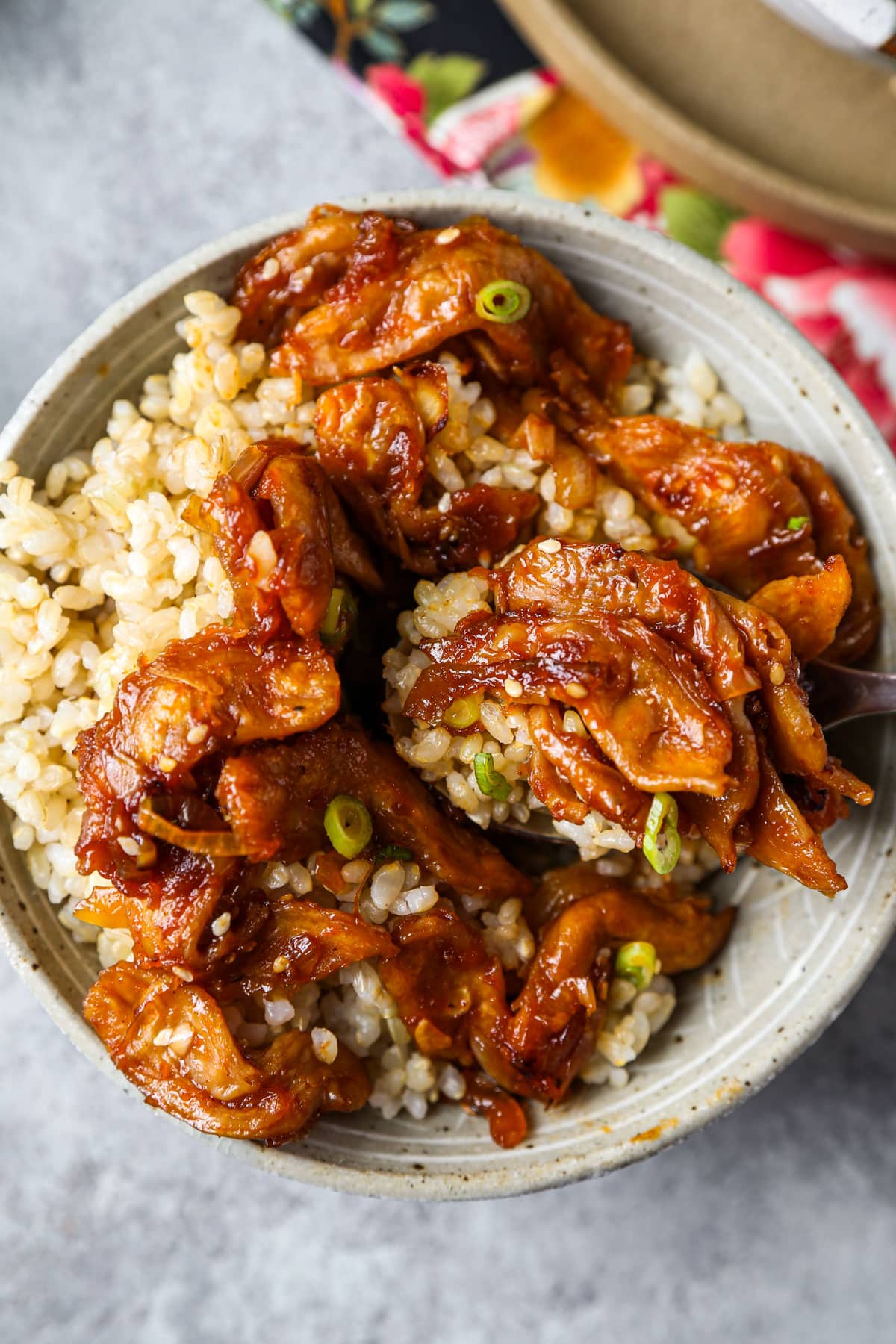
I was missing bulgogi. Since I dialed way back on my meat consumption, I’ve felt more than a few pangs of longing for thinly sliced Korean BBQ beef, marinaded in a magical fiery and sweet gochujang sauce – then grilled until lightly caramelized. One of my favorite weekend outings was going to late night Korean BBQ spots with friends for a few soju cocktails, and laying marinated ribeye on an in-table grill. So, when I set out to create a vegan version, I knew keeping the Korean flavors as traditional as possible was job #1 if I was hoping to capture the essence of an experience I cherished so much, and honor the assertive flavors and meaty textures of the original dish.
Table of Contents
Why This Recipe Works
- Soy curls mimic meat in the best way. Hearty and meaty – but 100% vegan.
- Traditional Korean flavors. I made sure it’s punchy, savory, sweet and smoky.
- Versatile. I love it over rice – and I also use it for ssam (Korean lettuce wraps).
How I Made it Vegan
I’m using soy curls instead of the usual beef. And, instead of marinating the protein, I’m whipping up a gochujang, sugar and soy based sauce that will be sauteed alongside the soy curls.
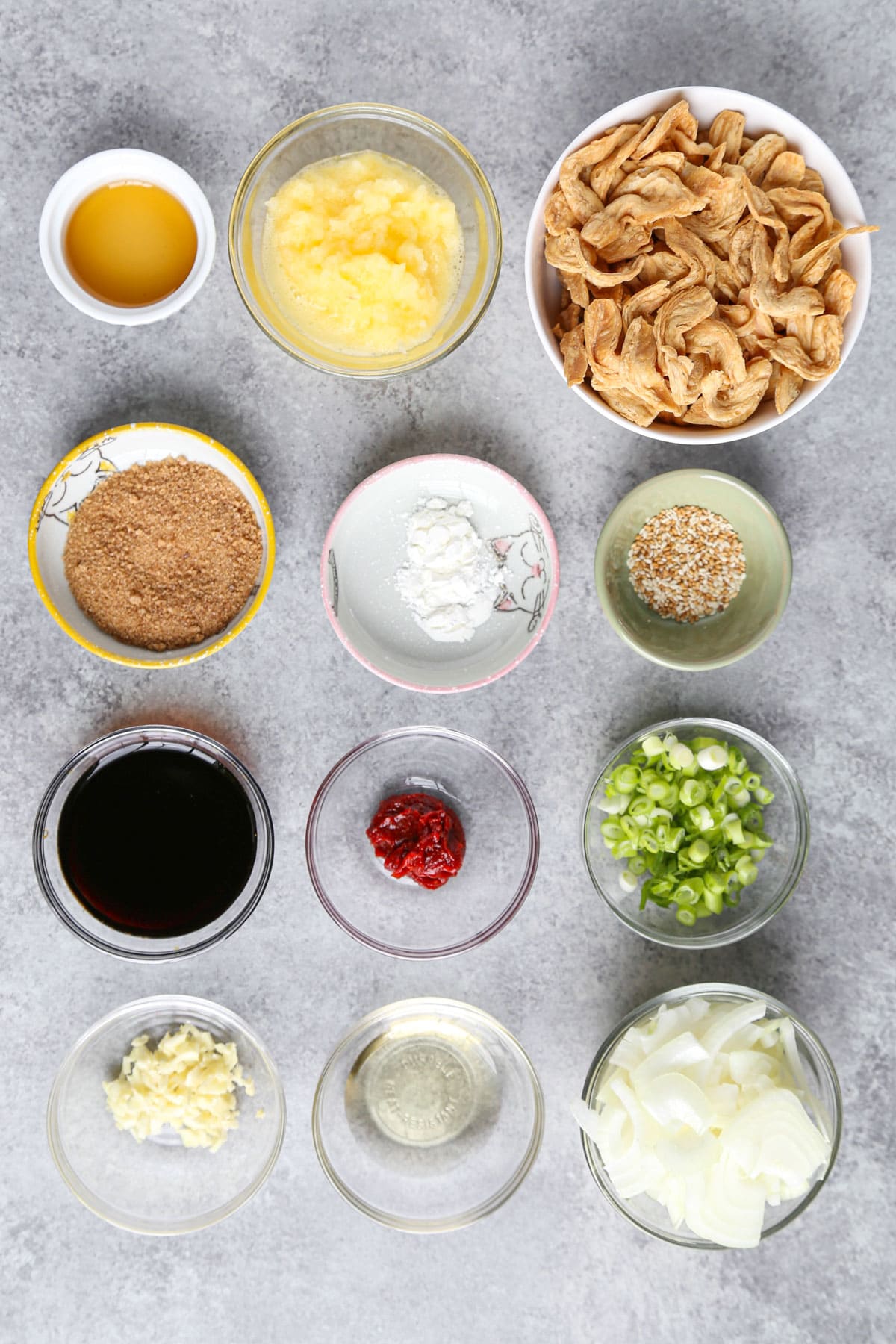
Ingredients
Scroll to the bottom of this page for the full recipe!
- Soy Curls or Soy Strips: This is soy based protein that, once rehydrated, has a soft, chewy texture and appearance very similar to chicken. These are the soy strips I used to make vegan bulgogi.
- Cooking Oil: I use a neutral oil like vegetable or grapeseed oil.
- Onion: Sliced into thin half moons, the onions soak in the bulgogi sauce and add a pleasing sweetness to the dish.
- Sesame Oil and Sesame Seeds: Toasty and nutty. I use the seeds as a garnish. And I always add the toasted sesame oil to the pan after I’ve turned the heat off, just before serving.
- Green Onions: Finely chopped scallions deliver a sharp fragrance and crunch.
- Ground Black Pepper: To taste.
Pro Tip Rehydrate your soy curls (or soy strips) in warm vegetable broth instead of water for an added savory element.
Bulgogi Sauce
- Soy Sauce: I use Japanese shoyu for salt and umami. But Korean soy sauce is great too (just lighter and a bit saltier).
- Brown Sugar: Raw brown sugar is best.
- Gochujang: This is Korean chili pepper paste. It’s salty, sweet, slightly spicy – with an umami funkiness. I consider it the backbone of the Korean flavor palate.
- Mirin: Slightly sweet and tangy.
- Grated Apple: Grated Asian pear and Korean pear are routinely used in beef bulgogi marinade. But apple works just as well as a bright flavor element – and is easier to find at the grocery store. Use whichever you prefer.
- Garlic: 2 cloves, minced.
- Cornstarch: I just use a teaspoon of cornstarch as a thickener for the sauce.


Other Meat Substitutes You Can Use
I usually use soy curls (or strips) for this plant based bulgogi recipe. They mimic the shape and texture of meat super well. But here are a few other meaty vegan suggestions.
- Tofu Cutlet: Firm tofu that’s been fried until golden brown. Slice the block into strips before using.
- Young Jackfruit: Also known as young green jackfruit. Find it in the canned section at Asian grocery stores. Do not use fresh, ripe jackfruit.
- Beyond Steak: These are very meaty strips made of wheat gluten and faba bean protein. Probably closest to the flavor of actual beef.
- Vegan Ground Beef: If you use a vegan ground beef product, it will soak up the sauce quickly. Have extra bulgogi sauce on hand just in case.
While traditional Korean bulgogi is made with beef, don’t worry if the meat substitute you choose looks like chicken – or not like meat at all.

How to Make Vegan Bulgogi
- Rehydrate the soy curls. Do this in a bowl with warm water or broth according to the instructions on the package. Then drain.
- Make the sauce. Whisk all of the sauce ingredients together and set aside.
- Cook. In a large skillet or wok over medium high heat, add the cooking oil and the onions and cook for 3 minutes. Add the soy curls and saute for 4 minutes. Then add half of the sauce and stir for 1 minute. After a minute, add the remaining sauce, stir and turn off the heat.
- Season and serve. Add the sesame oil, sesame seeds and stir well. Transfer to a serving plate and top with green onions and black pepper. Serve hot.
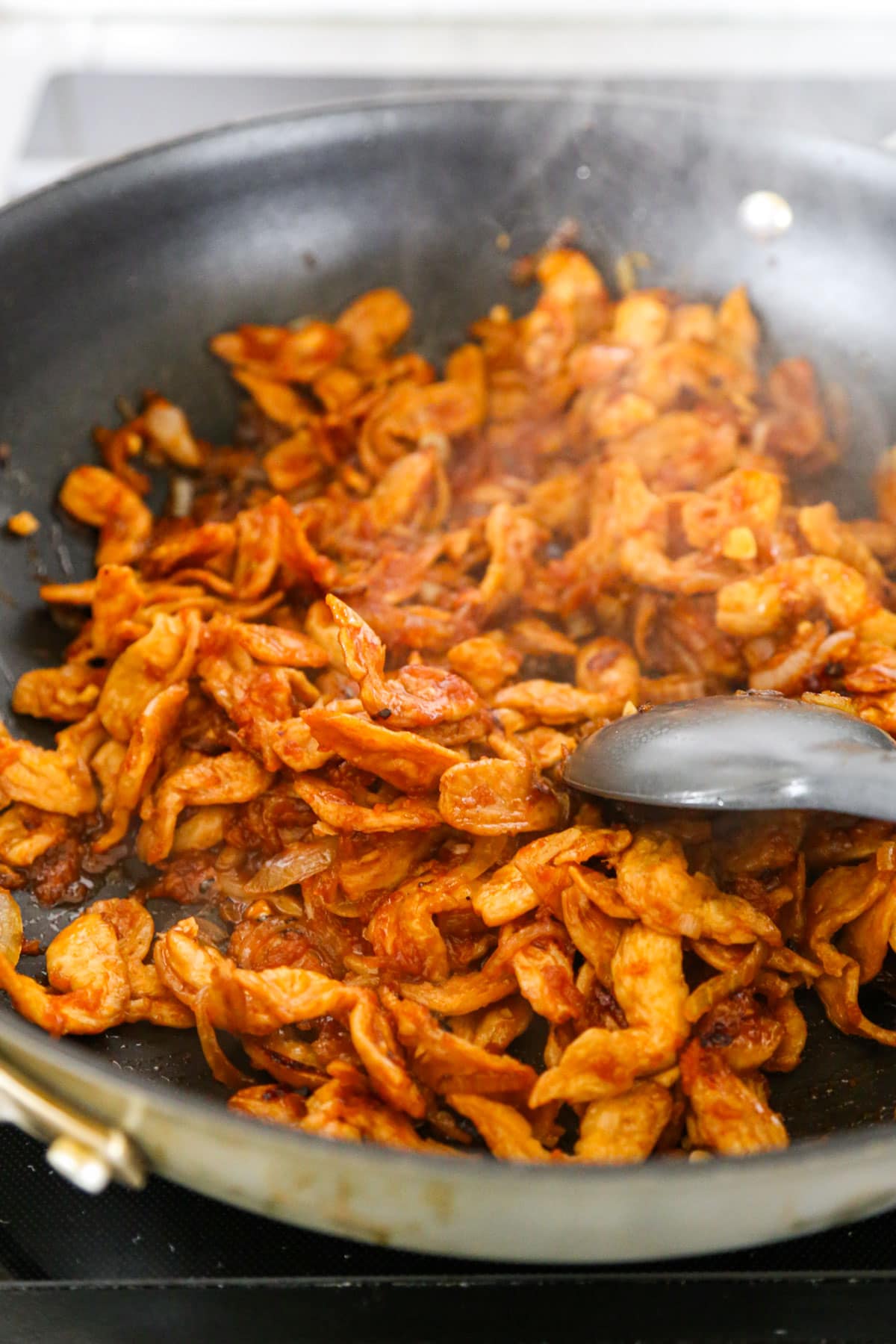
Recipe Variations
Tailor this vegan Korean bulgogi to your specific tastes with a few easy tweaks.
- Make it spicy. The only moderately spicy ingredient in this recipe is the gochujang. While gochujang has a bit of a bite, it’s fairly mild in terms of actual heat. Take it up a few notches with gochugaru (dried Korean red chili pepper flakes) – for a great balance of smoky and spicy.
- Go sweeter or less sweet. Just use more or less brown sugar in the sauce. I’ve also used monk fruit sweetener and agave nectar.
- Marinate the soy curls for more umami. You can easily infuse even more flavor into the soy curls with a quick soy sauce marinade. After rehydrating and draining the soy curls, place them in a food storage bag with 2 tablespoons of soy sauce for 10 minutes. Discard the marinade before cooking.
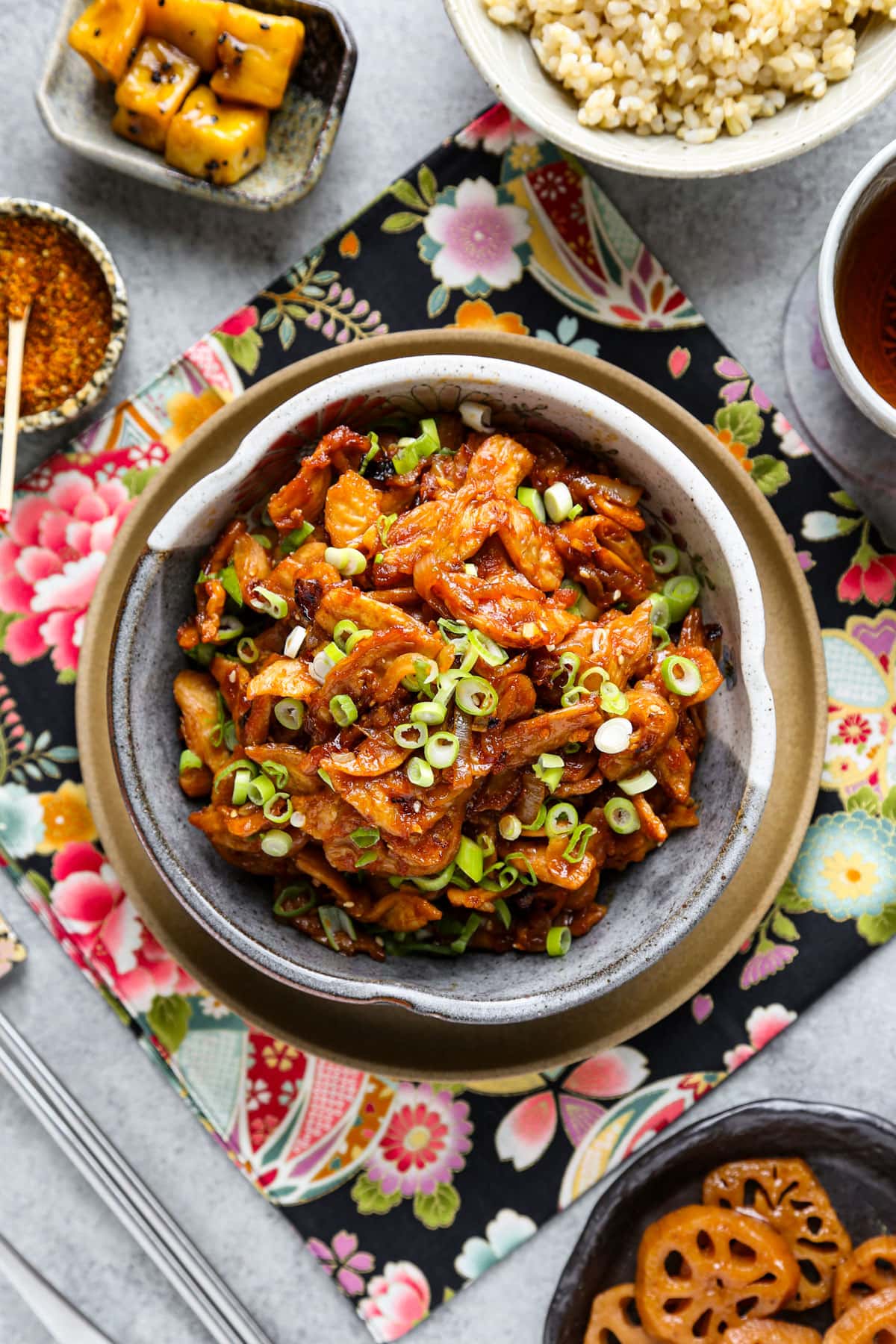
What to Serve With Bulgogi
I typically pair this recipe with a simple bowl of perfectly steamed white or brown rice.
And when I’m feeling particularly motivated, I like using this soy curl bulgogi to make vegan ssam. To make your own ssam, just wrap the bulgogi inside leafy lettuce leaves like red leaf lettuce or romaine. Parilla leaves work too. Then dip in those parcels in plenty of homemade ssamjang. Delicious!
Of course, it’s not a full-on Korean meal without a few banchan (Korean side dishes). Here are some banchan I love to pair up:

Storage
Cover and refrigerate leftover bulgogi for up to 3 days.
- Reheat leftovers in the microwave.
- If you want to recapture the fresh out of the pan flavor, top reheated leftovers with freshly chopped scallions, a light drizzle of soy sauce and a tiny bit of sesame oil.
Frequently Asked Questions
Only mildly spicy. The only source of heat is from gochujang (Korean red chili paste). Gochujang is more savory, funky and sweet overall. This vegan bulgogi recipe is perfect for people who love authentic Korean flavors, but may be sensitive to spice.
It can be. But you’ll have to make a couple changes. First, sub out the soy sauce in the recipe and use tamari or liquid aminos instead. Second, most mass produced gochujang contains barley malt powder, which is not gluten free. An easy workaround is to make your own gochujang. Here’s a quick homemade gochujang recipe you can follow. But heads up: that gochujang recipe contains honey (which isn’t vegan). You can use agave nectar instead if you prefer to make it both vegan and gluten free.
Toasted sesame oil has a low smoke point. It’s a great flavoring oil, but not a great cooking oil. The delicate, nutty flavor can quickly turn bitter if it gets too hot.
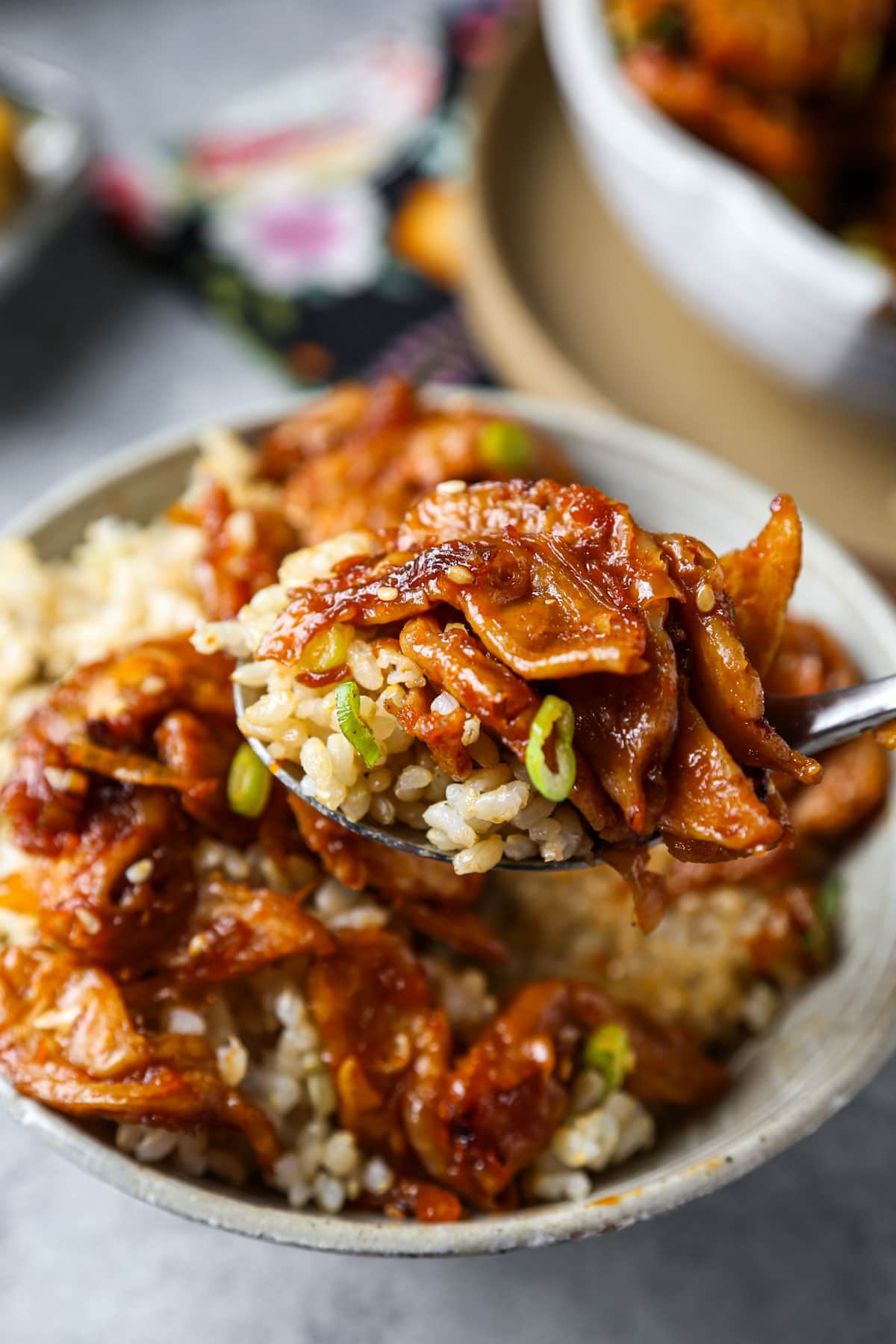
Subscribe to my newsletter and receive the latest recipes and weekly favorites straight to your inbox. Join me on Pinterest, Facebook, and Instagram for more cooking tips and adventures!
Did you like this recipe? Are there changes you made that you would like to share? Share your tips and recommendations in the comments section below!
Print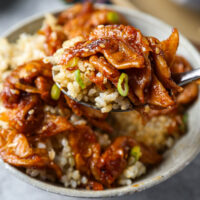
Vegan Bulgogi
- Prep Time: 15 minutes
- Cook Time: 10 minutes
- Total Time: 25 minutes
- Yield: 4 servings
- Category: Main
- Method: Skillet
- Cuisine: Korean
- Diet: Vegan
Description
My vegan bulgogi has the trademark savory, sweet, smoky caramelized goodness of the original Korean beef. 100% plant based and ready in 25 minutes!
Ingredients
- 2 cups soy curls
- 2 tablespoons vegetable or grapeseed oil
- 1 medium onion, thinly sliced into half moons
- 2 teaspoons sesame oil
- 1 teaspoon sesame seeds
- 3 green onions, finely chopped
- Ground black pepper, to taste
- Cooked white or brown rice, to serve with
Sauce
- 1/4 cup soy sauce
- 2 tablespoons brown sugar
- 1 tablespoon gochujang
- 1 tablespoon mirin
- 1 small red apple, peeled and grated
- 2 garlic cloves, minced
- 1 teaspoon cornstarch
Instructions
- Rehydrate the soy curls. Place the soy curls in a bowl with warm water and let sit for 10 minutes (follow specific rehydrating instructions in the package). The soy curls should be soft. Drain the soy curls and set them aside.
- Make the bulgogi sauce. Whisk all the ingredients for the sauce in a bowl and set aside.
- Cook the onions. In a large skillet over medium high heat, add the oil and swirl it to coat the surface evenly. Add the onion and saute for 3 minutes.
- Cook the soy curls. Add the soy curls and cook for 4 minutes.
- Add the sauce. Add HALF of the sauce and stir for 1 minute. Then add the remaining sauce to the skillet and stir.
- Final seasonings. Turn the heat off, add the sesame oil and sesame seeds, and stir.
- Garnish and serve. Top with green onions and season with ground black pepper. Serve with rice.
Notes
You can cover and store leftovers in the refrigerator for up to 3 days.
Nutrition
- Serving Size: 1 serving
- Calories: 267
- Sugar: 13.2g
- Sodium: 516mg
- Fat: 12.7g
- Saturated Fat: 1.1g
- Unsaturated Fat: 5.9g
- Trans Fat: 0g
- Carbohydrates: 25.4g
- Fiber: 8.4g
- Protein: 18.4g
- Cholesterol: 0mg
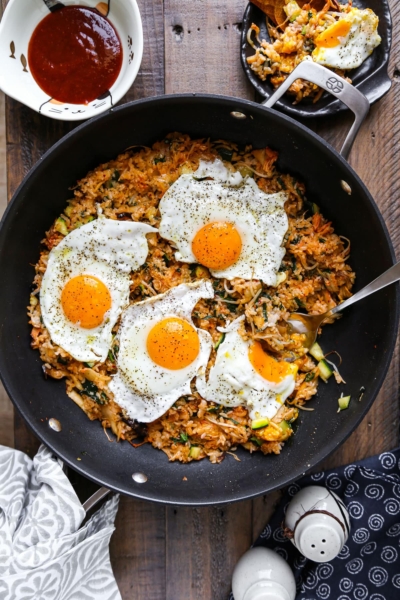
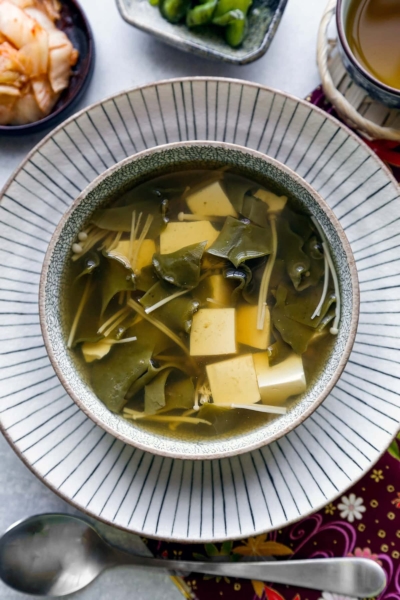
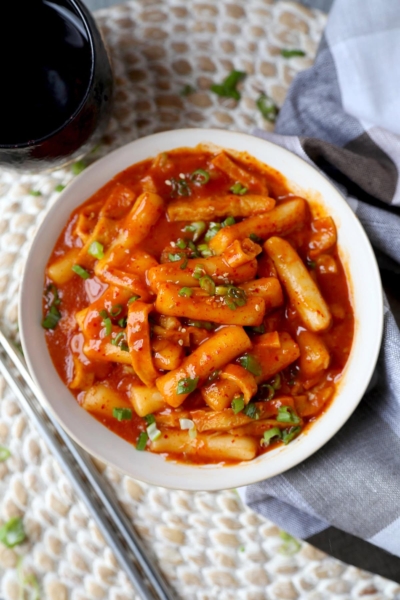
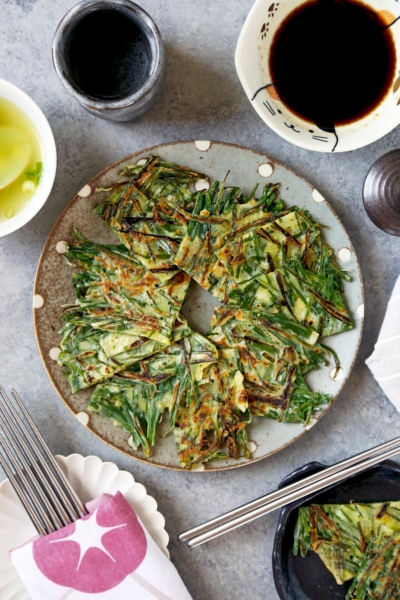
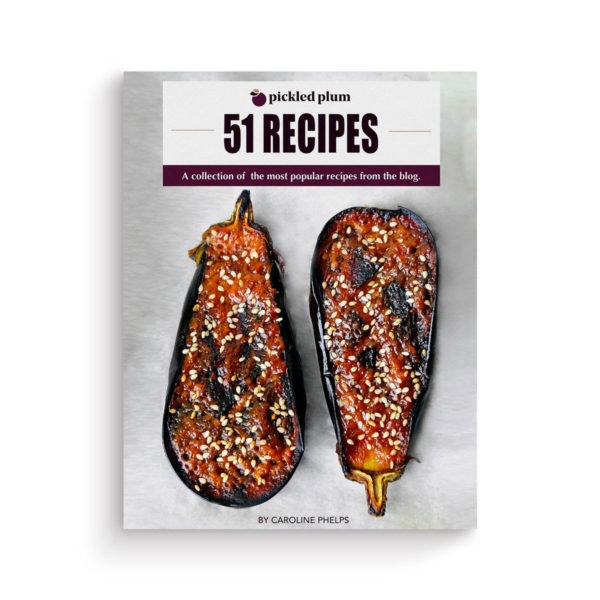
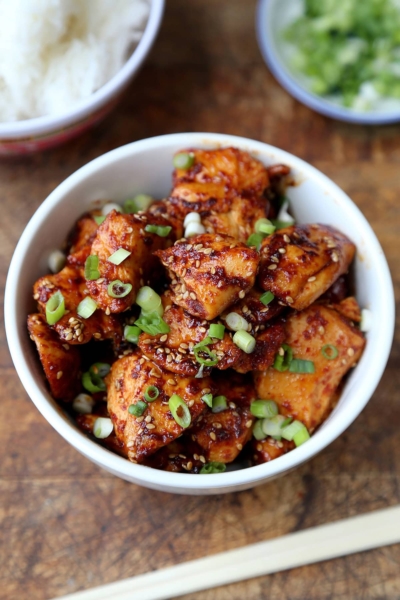
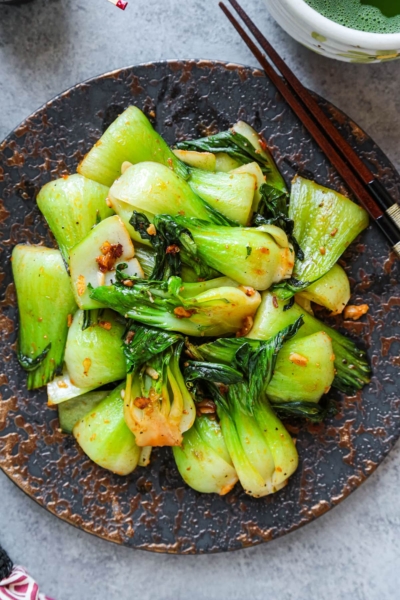
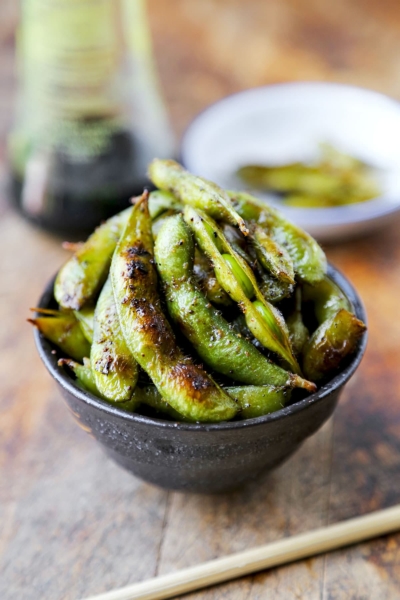
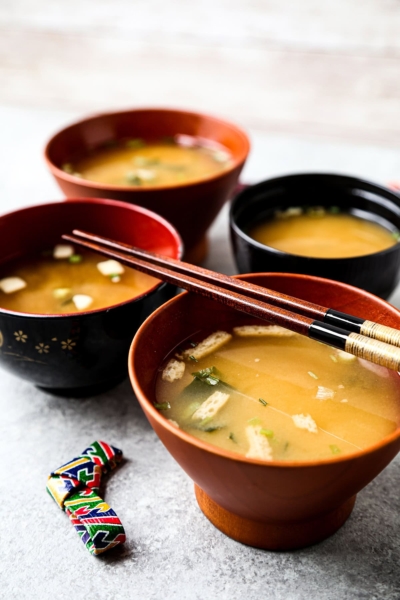
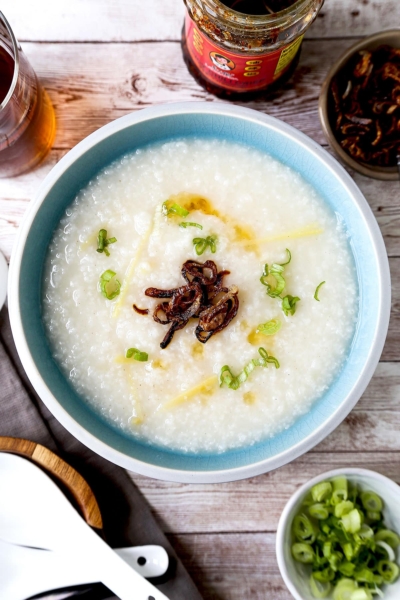
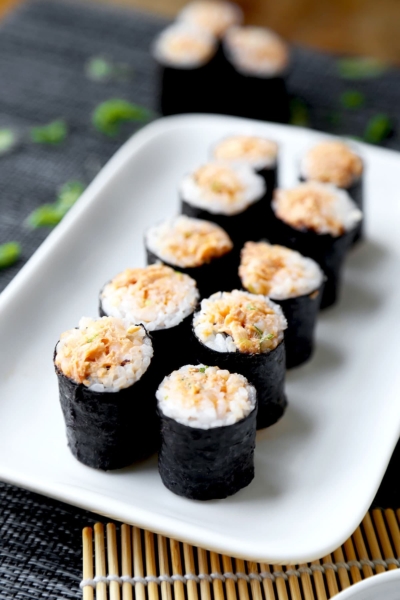








Questions and Reviews
So glad I gathered the ingredients. This was so good!